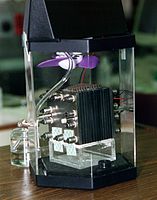
Photo from wikipedia
Abstract A solid oxide electrolysis cell (SOEC) powered by a renewable source can convert CO2 into carbon monoxide, which is a valuable feedstock for a range of fuels and chemical… Click to show full abstract
Abstract A solid oxide electrolysis cell (SOEC) powered by a renewable source can convert CO2 into carbon monoxide, which is a valuable feedstock for a range of fuels and chemical processes. The cathode material of the SOEC is required to possess sufficient catalytic activity for CO2 reduction, and also sustain the thermal and electrical load cycling to which the SOEC would be subjected when coupled with an intermittent renewable source without an auxiliary electricity or thermal storage system. The operating conditions can become even more challenging if solar or waste heat from exothermic downstream industrial processes is to be embedded in the process. In this study, we evaluated a mixed ionic–electronic conducting composite (La0·80Sr0.20Sc0.05Mn0·95O3-δ–Gd0.20Ce0·80O1.95) material as an SOEC cathode. Along with initial electrochemical performance, we investigated the cell's response to accelerated ageing tests, including electrical load cycling and extreme thermal cycling. Factors leading to performance degradation were studied by electrochemical impedance spectroscopy and structural characterisation of the cathode before and after the test. Thermal cycling resulted in more pronounced effect on the cell degradation rate as compared to electrical load cycling.
Journal Title: International Journal of Hydrogen Energy
Year Published: 2018
Link to full text (if available)
Share on Social Media: Sign Up to like & get
recommendations!